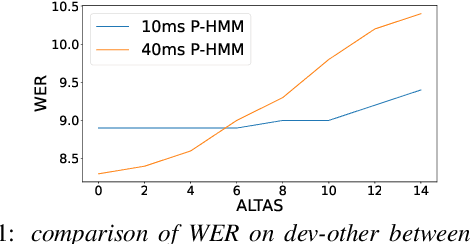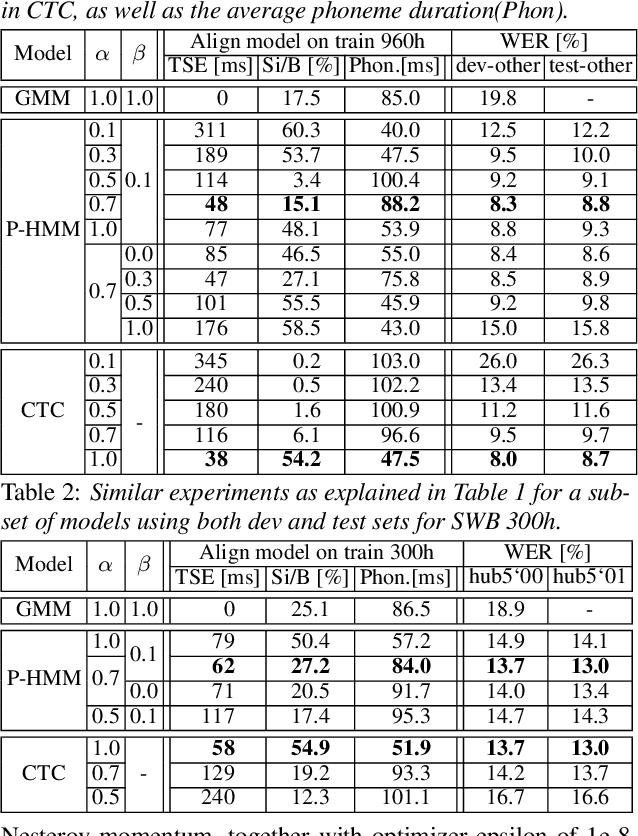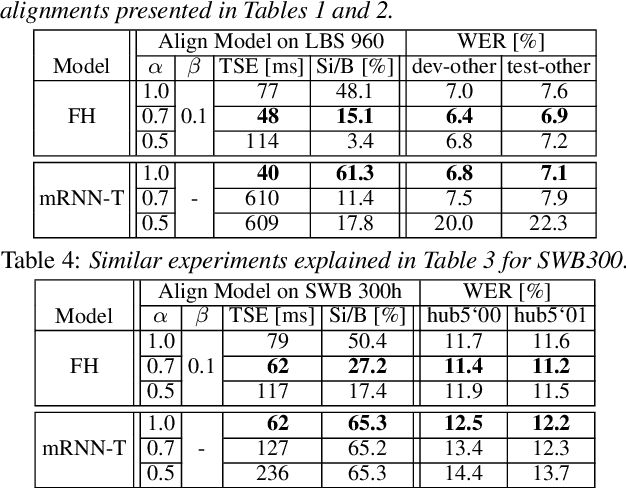Hermann Ney
Machine Learning and Human Language Technology, RWTH Aachen University, AppTek
Reproducing and Dissecting Denoising Language Models for Speech Recognition
Dec 15, 2025Abstract:Denoising language models (DLMs) have been proposed as a powerful alternative to traditional language models (LMs) for automatic speech recognition (ASR), motivated by their ability to use bidirectional context and adapt to a specific ASR model's error patterns. However, the complexity of the DLM training pipeline has hindered wider investigation. This paper presents the first independent, large-scale empirical study of DLMs. We build and release a complete, reproducible pipeline to systematically investigate the impact of key design choices. We evaluate dozens of configurations across multiple axes, including various data augmentation techniques (e.g., SpecAugment, dropout, mixup), different text-to-speech systems, and multiple decoding strategies. Our comparative analysis in a common subword vocabulary setting demonstrates that DLMs outperform traditional LMs, but only after a distinct compute tipping point. While LMs are more efficient at lower budgets, DLMs scale better with longer training, mirroring behaviors observed in diffusion language models. However, we observe smaller improvements than those reported in prior character-based work, which indicates that the DLM's performance is conditional on factors such as the vocabulary. Our analysis reveals that a key factor for improving performance is to condition the DLM on richer information from the ASR's hypothesis space, rather than just a single best guess. To this end, we introduce DLM-sum, a novel method for decoding from multiple ASR hypotheses, which consistently outperforms the previously proposed DSR decoding method. We believe our findings and public pipeline provide a crucial foundation for the community to better understand, improve, and build upon this promising class of models. The code is publicly available at https://github.com/rwth-i6/2025-denoising-lm/.
Dynamic Acoustic Model Architecture Optimization in Training for ASR
Jun 16, 2025Abstract:Architecture design is inherently complex. Existing approaches rely on either handcrafted rules, which demand extensive empirical expertise, or automated methods like neural architecture search, which are computationally intensive. In this paper, we introduce DMAO, an architecture optimization framework that employs a grow-and-drop strategy to automatically reallocate parameters during training. This reallocation shifts resources from less-utilized areas to those parts of the model where they are most beneficial. Notably, DMAO only introduces negligible training overhead at a given model complexity. We evaluate DMAO through experiments with CTC on LibriSpeech, TED-LIUM-v2 and Switchboard datasets. The results show that, using the same amount of training resources, our proposed DMAO consistently improves WER by up to 6% relatively across various architectures, model sizes, and datasets. Furthermore, we analyze the pattern of parameter redistribution and uncover insightful findings.
Regularizing Learnable Feature Extraction for Automatic Speech Recognition
Jun 11, 2025Abstract:Neural front-ends are an appealing alternative to traditional, fixed feature extraction pipelines for automatic speech recognition (ASR) systems since they can be directly trained to fit the acoustic model. However, their performance often falls short compared to classical methods, which we show is largely due to their increased susceptibility to overfitting. This work therefore investigates regularization methods for training ASR models with learnable feature extraction front-ends. First, we examine audio perturbation methods and show that larger relative improvements can be obtained for learnable features. Additionally, we identify two limitations in the standard use of SpecAugment for these front-ends and propose masking in the short time Fourier transform (STFT)-domain as a simple but effective modification to address these challenges. Finally, integrating both regularization approaches effectively closes the performance gap between traditional and learnable features.
Label-Context-Dependent Internal Language Model Estimation for CTC
Jun 06, 2025Abstract:Although connectionist temporal classification (CTC) has the label context independence assumption, it can still implicitly learn a context-dependent internal language model (ILM) due to modern powerful encoders. In this work, we investigate the implicit context dependency modeled in the ILM of CTC. To this end, we propose novel context-dependent ILM estimation methods for CTC based on knowledge distillation (KD) with theoretical justifications. Furthermore, we introduce two regularization methods for KD. We conduct experiments on Librispeech and TED-LIUM Release 2 datasets for in-domain and cross-domain evaluation, respectively. Experimental results show that context-dependent ILMs outperform the context-independent priors in cross-domain evaluation, indicating that CTC learns a context-dependent ILM. The proposed label-level KD with smoothing method surpasses other ILM estimation approaches, with more than 13% relative improvement in word error rate compared to shallow fusion.
Listen to the Context: Towards Faithful Large Language Models for Retrieval Augmented Generation on Climate Questions
May 21, 2025Abstract:Large language models that use retrieval augmented generation have the potential to unlock valuable knowledge for researchers, policymakers, and the public by making long and technical climate-related documents more accessible. While this approach can help alleviate factual hallucinations by relying on retrieved passages as additional context, its effectiveness depends on whether the model's output remains faithful to these passages. To address this, we explore the automatic assessment of faithfulness of different models in this setting. We then focus on ClimateGPT, a large language model specialised in climate science, to examine which factors in its instruction fine-tuning impact the model's faithfulness. By excluding unfaithful subsets of the model's training data, we develop ClimateGPT Faithful+, which achieves an improvement in faithfulness from 30% to 57% in supported atomic claims according to our automatic metric.
Classification Error Bound for Low Bayes Error Conditions in Machine Learning
Jan 27, 2025


Abstract:In statistical classification and machine learning, classification error is an important performance measure, which is minimized by the Bayes decision rule. In practice, the unknown true distribution is usually replaced with a model distribution estimated from the training data in the Bayes decision rule. This substitution introduces a mismatch between the Bayes error and the model-based classification error. In this work, we apply classification error bounds to study the relationship between the error mismatch and the Kullback-Leibler divergence in machine learning. Motivated by recent observations of low model-based classification errors in many machine learning tasks, bounding the Bayes error to be lower, we propose a linear approximation of the classification error bound for low Bayes error conditions. Then, the bound for class priors are discussed. Moreover, we extend the classification error bound for sequences. Using automatic speech recognition as a representative example of machine learning applications, this work analytically discusses the correlations among different performance measures with extended bounds, including cross-entropy loss, language model perplexity, and word error rate.
Right Label Context in End-to-End Training of Time-Synchronous ASR Models
Jan 08, 2025



Abstract:Current time-synchronous sequence-to-sequence automatic speech recognition (ASR) models are trained by using sequence level cross-entropy that sums over all alignments. Due to the discriminative formulation, incorporating the right label context into the training criterion's gradient causes normalization problems and is not mathematically well-defined. The classic hybrid neural network hidden Markov model (NN-HMM) with its inherent generative formulation enables conditioning on the right label context. However, due to the HMM state-tying the identity of the right label context is never modeled explicitly. In this work, we propose a factored loss with auxiliary left and right label contexts that sums over all alignments. We show that the inclusion of the right label context is particularly beneficial when training data resources are limited. Moreover, we also show that it is possible to build a factored hybrid HMM system by relying exclusively on the full-sum criterion. Experiments were conducted on Switchboard 300h and LibriSpeech 960h.
Prompting and Fine-Tuning of Small LLMs for Length-Controllable Telephone Call Summarization
Oct 24, 2024



Abstract:This paper explores the rapid development of a telephone call summarization system utilizing large language models (LLMs). Our approach involves initial experiments with prompting existing LLMs to generate summaries of telephone conversations, followed by the creation of a tailored synthetic training dataset utilizing stronger frontier models. We place special focus on the diversity of the generated data and on the ability to control the length of the generated summaries to meet various use-case specific requirements. The effectiveness of our method is evaluated using two state-of-the-art LLM-as-a-judge-based evaluation techniques to ensure the quality and relevance of the summaries. Our results show that fine-tuned Llama-2-7B-based summarization model performs on-par with GPT-4 in terms of factual accuracy, completeness and conciseness. Our findings demonstrate the potential for quickly bootstrapping a practical and efficient call summarization system.
The Conformer Encoder May Reverse the Time Dimension
Oct 01, 2024Abstract:We sometimes observe monotonically decreasing cross-attention weights in our Conformer-based global attention-based encoder-decoder (AED) models. Further investigation shows that the Conformer encoder internally reverses the sequence in the time dimension. We analyze the initial behavior of the decoder cross-attention mechanism and find that it encourages the Conformer encoder self-attention to build a connection between the initial frames and all other informative frames. Furthermore, we show that, at some point in training, the self-attention module of the Conformer starts dominating the output over the preceding feed-forward module, which then only allows the reversed information to pass through. We propose several methods and ideas of how this flipping can be avoided. Additionally, we investigate a novel method to obtain label-frame-position alignments by using the gradients of the label log probabilities w.r.t. the encoder input frames.
Investigating the Effect of Label Topology and Training Criterion on ASR Performance and Alignment Quality
Jul 16, 2024



Abstract:The ongoing research scenario for automatic speech recognition (ASR) envisions a clear division between end-to-end approaches and classic modular systems. Even though a high-level comparison between the two approaches in terms of their requirements and (dis)advantages is commonly addressed, a closer comparison under similar conditions is not readily available in the literature. In this work, we present a comparison focused on the label topology and training criterion. We compare two discriminative alignment models with hidden Markov model (HMM) and connectionist temporal classification topology, and two first-order label context ASR models utilizing factored HMM and strictly monotonic recurrent neural network transducer, respectively. We use different measurements for the evaluation of the alignment quality, and compare word error rate and real time factor of our best systems. Experiments are conducted on the LibriSpeech 960h and Switchboard 300h tasks.
 Add to Chrome
Add to Chrome Add to Firefox
Add to Firefox Add to Edge
Add to Edge